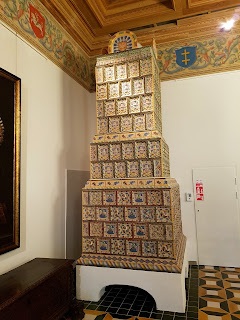During our holidays in Lithuania we visited Palace of the Grand Dukes of Lithuania and the Bell Tower. One of the reasons was that we live in Northern Ireland and my kids have no such understanding about Lithuanian history as I would like them to have. So we tried to touch Lithuania history a little bit, and definitely, it was not the last time :)
In the Palace of the Grand Dukes you can find two exhibition tour routes directly related to the historical functions of this residence. The first floor is the excavated foundations and cellars of the old palace complex, with many archaeological finds in-situ. There is a lot of good diagrams and text to give the visitors a clear idea of what they are looking at.
A fortified wooden settlement existed on the site of the Grand Dukes’ Palace from the 4th to the 8th centuries. During the 13th and 14th centuries it was converted into a well-fortified castle with brick walls. At the end of the15th and the beginning of the 16th centuries, the Gothic-style castle of the Middle Ages was transformed into a luxurious Renaissance-style residence. During the 17th century, the palace was reconstructed in the early Baroque style and the rulers of Lithuania and Poland who lived there amassed large collections of famous artworks and disseminated new cultural ideas throughout the country.
The upper floors take you through the various stages of Lithuania's history and the founding of the country. There is excellent information and a good deal of unique objects.
The views from the top of the tower are excellent and the room is enclosed in glass, with cushions provided to sit and take in the city properly.
One of the most distinctive features of the square is the Cathedral's bell tower, situated several yards from the cathedral itself. The belfry is an element of key importance in the complex of the Vilnius Archcathedral Basilica and the Higher and Lower Castles.
The 13th century tower originally was part of the defensive wall. Its ground floor has survived almost in its entirety. In the 16th century, the defensive tower was converted into the cathedral belfry. The height of the belfry of the Vilnius Cathedral is 52 metres (57 metres with the cross).
The main function of a belfry is the tolling of bells. Bells are cast from bronze (approximately 77 % copper and 23 % tin), and are decorated with ornaments, coats of arms and quotes from the Holy Scripture. Before mounting them onto the belfry, church bells are consecrated and very often named after the saints.
You can have a close look at the bells and listen to their sound
Impressive view of the city (50 m down)
The history of bells began 3000 years ago in Asia. The most ancient bell was found in Babylon. The first bells were produced from metal plate, and legend goes that it was Bishop Pontius Meronius Paulinus who cast the first bronze bell circa 410, having borrowed the form of a wild flower. The earliest bell that has survived in Europe was produced in 613 and today is held in Cologne.
Bells served different functions in different cultures. In ancient Rome they invited people to bathhouses and gatherings, announced the beginning and the end of wars, and tolled when an armistice was concluded, the winners were saluted, and during ceremonial festivities. In the Middle Ages people believed that the sound of bells scares the evil spirits away, stops the spread of epidemics and diverts the storms. Today, the tolling of church bells invites the believers for a joint prayer and announces church and public holidays.
The Cathedral of Vilnius

































No comments:
Post a Comment